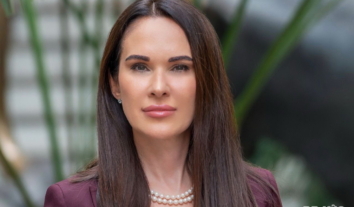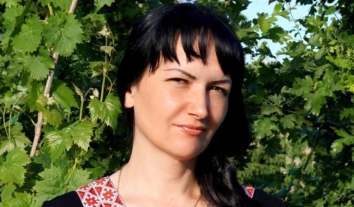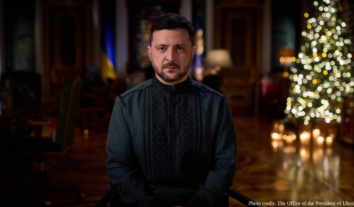How confessions are suppressed by militants in Donbas (PHOTOS)
Once certain areas of Donetsk and Luhansk regions became controlled by Russian-backed separatist formations in 2014, the situation with observance of human rights and freedoms, including freedom of conscience, got dramatically complicated there.
The reprisals on religious grounds began with a wide and intensive use of religious rhetoric to mobilize supporters of illegal armed formations (IAF). Accordingly, the parishioners of the churches, whom the Orthodox fundamentalists consider to be “harmful”, became subjected to systematic persecutions and suffered spontaneous acts of aggression since the very first days.
2014
May 16, 2014, bishop of evangelical association “God’s Church of Ukraine” Oleksiy Demydovych was detained for several hours, and the premises of the Pentecostal Church “Good News” were seized soon.
June 6, 2014, the representatives of the illegal armed groups seized the property of Christian children’s shelter “Sails of Hope” in the town of Slovyansk. June 8, 2014, deacons Viktor Bradarsky and Volodymyr Velychko, as well as Ruvym Pavenko and Albert Pavenko (the sons of senior pastor Oleksandr Pavenko) were abducted from the premises of the church of “Transfiguration of the Lord” after celebration of the holiday of Pentecost. All four men were found dead the next day.
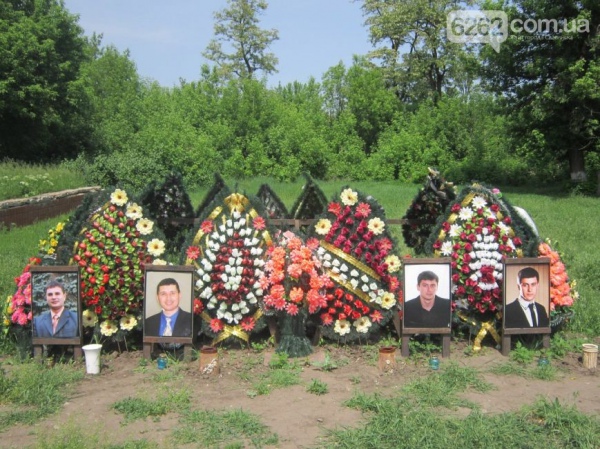
Earlier, May 9, 2014, freelance priest of the Ukrainian Orthodox Church of the Moscow Patriarchate Pavlo Zhuchenko was killed at a roadblock. The premises of protestant churches in Horlivka and other villages and towns were seized, pastors and active members of religious organizations were abducted and beaten many times.
Thus, May 23, three Protestant believers, including pastor of the “God’s Assembly” church Serhiy Kosiak, were beaten in Donetsk.
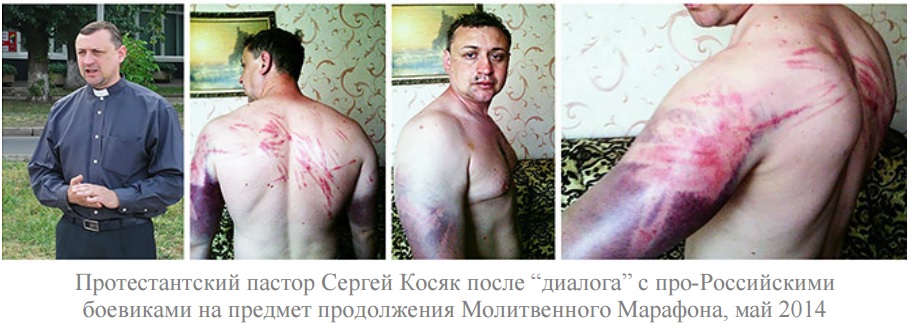
Caption: Protestant pastor Serhiy Kosiak after “a dialogue” with pro-Russian militants over continuation of the prayer marathon, May 2014
May 27, Polish Catholic priest Pavlo Witko was kidnapped and held in captivity for almost a day.
Kidnapping, assaults, and seizure of churches became commonplace during the summer of 2014.
During the second half of June, the premises of Protestant churches in Donetsk, Horlivka, Torez, Shakhtarsk, Druzhkivka and other towns were seized.
The IAF representatives held captive pastor of “Church of Winners” of Druzhkovka town Pavlo Lesko and his wife for a week starting from June 26.
July 3-14, priest of the Ukrainian Greek Catholic Church Tykhon Kulbaka was held captive.
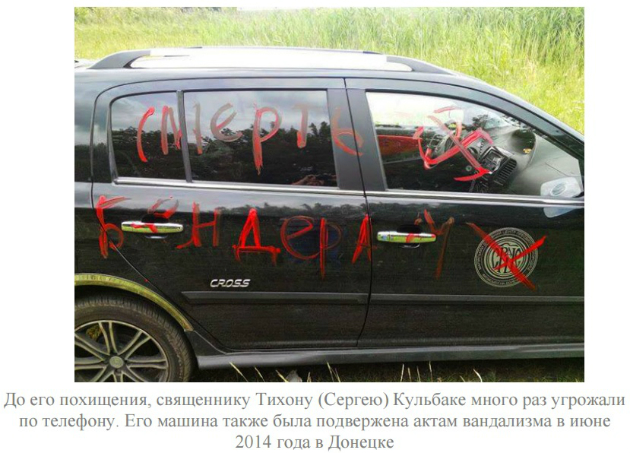
Caption: Tykhon (Serhiy) Kulbaka had received many threats on the phone before he was abducted. His car was also subjected to acts of vandalism in Donetsk in June 2014.
July 8-30 – priest of the Ukrainian Orthodox Church of Kyiv Patriarchate (UOC KP) Yuri Ivanov was held captive. July 15-25 – priest of the Roman Catholic Church Viktor Vonsovych was held captive.
August 4-12 – Protestant pastor Oleksandr Khomchenko was held captive.
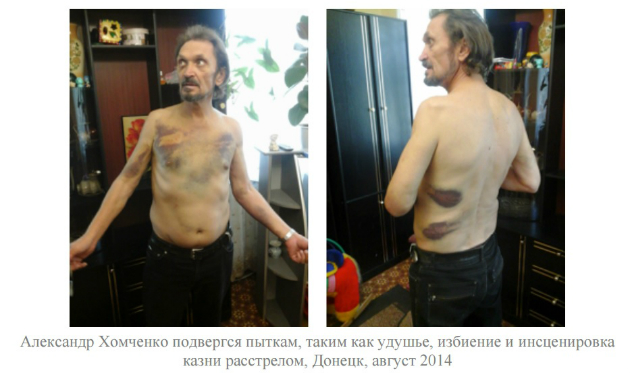
Caption: Oleksandr Khomchenko was subjected to such tortures as choking, beating, mock execution by shooting. Donetsk, August 2014.
As for Islam representatives, head of the Muslim community in Luhansk Saifullah Rashydov was twice arrested and imprisoned within this period. Imam-Khatib of the Muslim community of Snizhne town Shamil Bohdanov and I, Mufti of the Religious Administration of Muslims of Ukraine “Ummah” Sheikh Said Ismahilov, were forced to leave the occupied part of Donbas because of persecutions and attempts of arrest.
These are not merely incidents of kidnapping of priests and religious figures. These offenses could be partially explained as an attempt to seize the property. People were kidnapped very often then and not always because of religious preferences. However, at least a significant portion of them is persecution on religious grounds.
Many religious organizations, especially representatives of religious minorities and new religious movements, quickly evacuated their representatives from the towns which were no longer controlled by the government of Ukraine. It is true about, for example, the Church of Jesus Christ of Latter-day Saints, some Protestant and Jewish communities.
Not only representatives of Christian denominations suffered persecutions then. For example, the premises of the Buddhist Order “Nippondzan Mehodzi” in the village of Pankivka in Luhansk region were seized in early July 2014. It was one of the most important centers of that religious organization in Ukraine. The representatives of this confession, who resided on the territory controlled by the illegal armed groups, were also persecuted. They had to leave their community and move to the territory controlled by the Ukrainian government.
Order “Nippondzan Mehodzi” is known for its actions calling for peace. Shortly before the Luhansk and Donetsk communities were assaulted, the Order became the organizer of the nationwide event called “March for Peace and Solidarity in Ukraine.”
The activity of other Buddhist communities also stopped, particularly that of the Sheychen-Ling monastery in the village of Olhynka in Donetsk region. The monastery was closed and its prior, Zhamba Choydzhe Dorji Lama (secular name Oleh Muzhchyl) joined the Right Sector movement, leading one of its units, and was killed in hostilities in 2014.
2015
In 2015, the persecutions on religious grounds did not stop, though the incidents became less common. One of the reasons was that prominent pro-Ukrainian faithful left the areas controlled by the illegal armed groups.
The reprisals started to abate also because of departure or death of many members of the paramilitary movements (Cossacks, skinheads and others), who came from Russia in 2014.
Over this period, attacks were launched on chaplain from the UOC KP Ihor Petrenko (February 14, he mistakenly drove to the roadblock of the illegal armed formation of Donetsk region and was beaten, but released on April 6 under the prisoner exchange program), Pentecostal pastor Taras Sen (he was held captive by the IAF unit which declared itself “Ministry of State Security of Luhansk People’s Republic” within September 23 – October 6). Jehovah’s witnesses were repeatedly attacked. In particular, their premises in Donetsk, Yenakiyeve, Bryanka were seized. The premises which belonged to other denominations were also seized.

Caption: DPR militants carrying a shell in the premises of the Church of Christ in Donetsk, March 2015. Photo credits: Francesco Volpi for Al Jazeera America
2016
Kidnappings gradually decreased after many religious leaders of different denominations had left, but the seizure of places of worship continues.
One of the recent incidents is seizure of the premises belonging to the Mormons in Donetsk in May 2016: the premises, which were not functioning at the time because of evacuation of the community, were turned into the “Wedding Palace.”
A year before, in the spring of 2015, the main house of prayer of this church in Donetsk was turned into a “Palace of Children and Youth.”
The premises of the Church of Jesus Christ of Latter-day Saints are in good condition so they often are a desirable goal.
Such a goal was the academic buildings and dormitories of the Donetsk Christian University, captured on July 9, 2014 and turned into barracks.
However, there are churches, which managed to save themselves in 2014 and operate until now despite some limitations. Thus, despite the oppression, the Ukrainian Greek Catholic Church operates in Donetsk and Luhansk. In spring of 2016, the Donetsk community was even visited by newly appointed Apostolic Nuncio in Ukraine Claudio Gugerotti. He attended the Easter service.
The communities of Jehovah’s Witnesses also work. Representatives of the International Society for Krishna Consciousness carry out charitable activities mostly.
The Muslim communities are operating despite the departure of the best known imams, and some of their leaders claim to supreme status within the breakaway entities. The Ukrainian Orthodox Church (Moscow Patriarchate) operates without any obstacles, not taking into account individual reprisals against pro-Ukrainian clergy.
FREEDOM OF CONSCIENCE
Apart from specific cases of persecution, kidnappings and property seizures, the freedom of conscience situation worsens.
The illegal armed groups, which control the territory, are not subjects of international law and do not think they must obey it. The laws of Ukraine on the uncontrolled territory are not observed or almost are not observed, so the Ukrainian authorities cannot ensure the right to freedom of conscience there.
This is evidenced by the draft resolution No. 2765 (462-VIII), approved on May 21, 2015, by which the Ukrainian Parliament temporarily suspended its commitments to observance of human rights and fundamental freedoms in the areas of Donbas beyond the government’s control.
In addition, the legal framework of the illegal armed formation of Donetsk and Luhansk regions is very unstable. Thus, June 24, 2016, a law was adopted to regulate the legal relations in the field of the freedom of conscience (the authors prefer to speak of “freedom of religion” as they consider that freedom of conscience is a “Western standard” which is harmful to religious people).
Earlier, there was no proper regulation of legal relations in the field of freedom of conscience and statements of various members of the IAF often contradicted each other.
Thus, Article 21 of the “Constitution” of the IAF of Donetsk region, which was adopted in May 2014, guarantees everyone the freedom of conscience, freedom of worship and professing any religious or other beliefs. On the other hand, in his famous speech of May 20, 2015, Oleksandr Zakharchenko said that only four religious denominations would be legitimate on the territory controlled by his organization: Orthodoxy, Roman Catholicism, Islam and Judaism.
The law on freedom of religion and religious associations, which has been recently approved in Donetsk region, on the one hand, guarantees the right to freedom of worship (but not conscience), on the other hand, Article 3 (paragraph 6) prohibits “creation of sects and spread of sectarianism”. As there is no definition of sects, it creates preconditions for reprisals against virtually any religious organization.
So, speaking of observance of human rights and freedom of conscience and of reprisals on religious grounds in the territories controlled by the IAF, we should identify two areas.
First, the reprisals against members of certain religious organizations. The majority of incidents are abduction, physical violence, seizure of property and seizure of places of worship. These incidents were mostly common in 2014, and their number subsequently declined for different reasons.
Second, a systematic deterioration in freedom of conscience because of the general instability in the region and establishment of a special legal framework on the territory controlled by the IAF.
Of course, it is necessary to follow all the facts of persecutions and reprisals on religious grounds and the Ukrainian authorities and civil society must provide this information to the international organizations in order to make the representatives of IAF and Russia, which backs them, observe the human rights.
Sheikh Said Ismahilov, Mufti of the Religious Administration of Muslims of Ukraine “Ummah”



